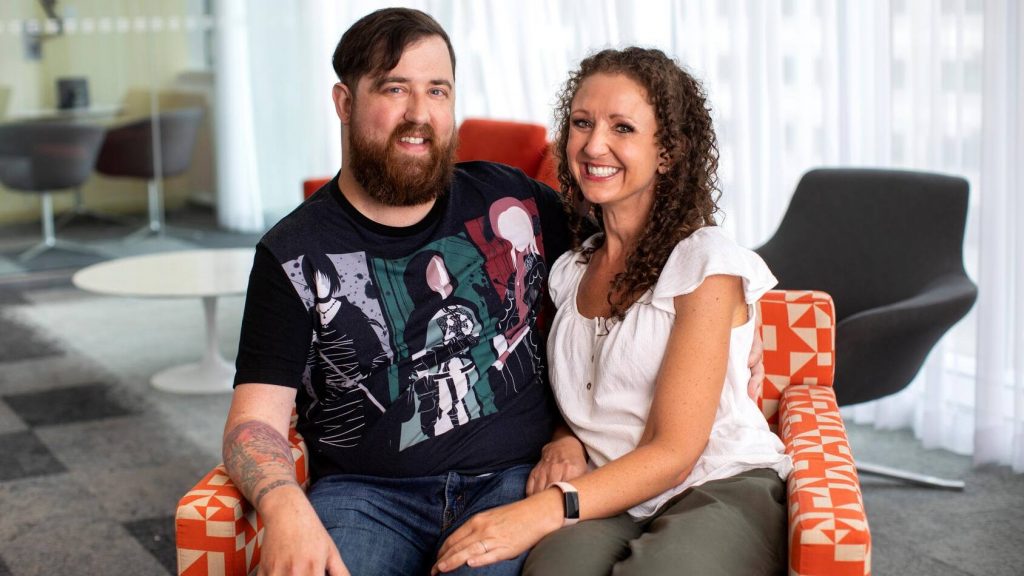
At 34, Steven Graham has already beaten the odds. Born with a heart defect, doctors predicted that he would not live past 30.
But over the years and a series of pacemakers, his heart was giving out, and he needed a transplant. Complicating matters, Steven's declining cardiac muscle was also damaging his lungs.
His physicians said he would need a heart and lung transplant. Then came the tough news that they no longer could help him. That's when Steven came to Mayo Clinic.
"I had never been able to chase her or pick her up and carry her any sort of extended distance. Now that she was bigger, it was very much like, ‘OK, like I want to be a dad.’"
That dedication to daughter, Ari, and wife, Randi, motivated Steven to conquer a rare heart defect.
Born with his heart in backward, Steven survived surgery as a baby to correct a transposition of his great arteries. But by age 30, his heart was failing, and he needed a transplant.
"Really kind of simple things like that, just going up and down the block would be a challenge. Yeah, It was scary. It was scary.”
Watch: A regenerative bridghttps://www.youtube.com/watch?v=ZwrdESzXAuce to transplant
Journalists: Broadcast-quality video (4:09) is in the downloads at the end of this post. Please courtesy: "Mayo Clinic News Network." Read the script.
Steven came to Mayo Clinic when his doctors said they could no longer help him. His declining heart damaged his lungs. He was facing the prospect of a complex heart and lung transplant.
"If he didn't get the heart transplant, I think his prognosis would have been in months, basically. He did have pulmonary hypertension, but we thought that we might be able to reverse that and get him to a point where he would be fine with a heart transplant alone," says cardiologist, Dr. Sudhir Kushwaha.
The Transplant Team proceeded with a regenerative intervention together with medication as a bridge to transplant. They inserted a mechanical a balloon pump to boost Steven's heart circulation and restore lung function.
"Then the balloon pump is essentially a second pump in the body. So it complements the heart’s function and driving forward flow, and really reduces the burden on a failing heart to work," explains cardiologist Dr. Atta Behfar.
The standard way of implanting the balloon pump is through the leg. But that's grueling on patients who must remain bedbound their entire time with the pump.
What really made the difference for Steven is Mayo Clinic discovered a way of making it easier on patients by placing the pump through an artery in the arm, giving access to the descending aorta.
That gave Steven the flexibility to get up and move around with the balloon pump working inside. And he could tolerate it for a longer period of time.
"You know, weeks and weeks, rather than days. We could suddenly think about maybe truly reversing the lung pressures, regenerating the lung to a point where now he would again be able to qualify for heart transplant," adds Dr. Behfar.
Time is what Steven needed to reverse years of lung damage. But it came as a mixed blessing for his family.
"I get the call that he's not going to be able to come home until a heart becomes available. And so then, it became, 'Oh, man, when am I gonna see you again?’ So, yeah, it was so much grief," says Steven's wife Randi.
Steven resolved that it would be a short time until his family had him back. He turned his focus from waiting for a heart to getting in shape for a transplant.
"But that's when I was like, 'Can I have a stationary bike?' So I rode the stationary bike 10 miles a day. Cause, you know, if you're bedridden, you’re just like, your muscles aren’t doing anything, and they are going to atrophy and fall away," says Graham.
After two months, Steven's grit and determination paid off with the gift of a new heart. The exercise, medication and balloon pump all contributed to a strong recovery.
He was discharged from the hospital just two weeks after his heart transplant ― in time for a double celebration: his daughter's birthday and the start of a new life.
"I mean everything is a lot easier physically. I can do pretty much anything I want to do. I can pick her up and swing around and chase her ― things I literally could not do before," says Graham.
The Grahams never lost hope this day would come. They credit faith, confidence in the medical team and support of friends, family and the hospital chaplain.
"And as far as goals for the future, I just want to protect and nurture what I've been given and make sure that I am a worthy example," says Graham.
_____________________________
For the safety of its patients, staff and visitors, Mayo Clinic has strict masking policies in place. Anyone shown without a mask was recorded prior to COVID-19 or recorded in an area not designated for patient care, where social distancing and other safety protocols were followed.







